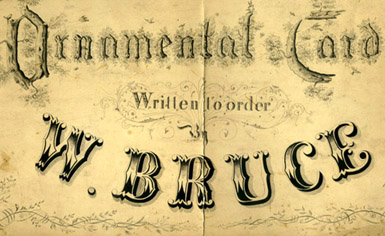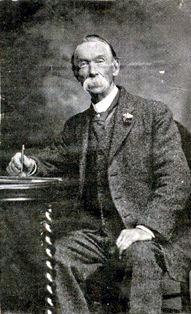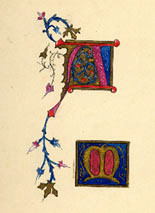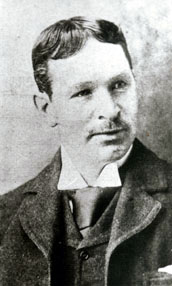 William attended Mr.
McIndoe’s dancing school as part of his education at the grammar school. The boys
went to the school, taught by Mr. McIndoe and his son, once a week for social training.
William attended Mr.
McIndoe’s dancing school as part of his education at the grammar school. The boys
went to the school, taught by Mr. McIndoe and his son, once a week for social training.THE HEART OF THE CITY
WILLIAM BRUCE
17 1/2 King Street East
(pre-1890 address 14 1/2 King Street East)
 William Bruce was an
important character in the early days of Hamilton. He opened a patent office at 17 ½ King
Street East in 1867, but he was known for much more than that. Throughout his lifetime,
which spanned almost a century, William Bruce helped Hamilton develop into what it is
today.
William Bruce was an
important character in the early days of Hamilton. He opened a patent office at 17 ½ King
Street East in 1867, but he was known for much more than that. Throughout his lifetime,
which spanned almost a century, William Bruce helped Hamilton develop into what it is
today.
William Bruce was born on the Isle of Unst in the Shetland Islands, Scotland, on November 7, 1833. He was the eldest of 12 children. He immigrated to Canada with his family in 1837. During the 12 weeks voyage, the ship on which the Bruce family was travelling, sprang a leak in the middle of the ocean. William’s father was crucial to keeping the ship afloat. He had been a sailor who was twice shipwrecked off the coast of Greenland and survived both ordeals. His know-how aided the ship tremendously and the passengers eventually floated safely into Hamilton Harbour. Eleven more siblings were born into the Bruce family, but not all of them survived. Most of the children in the Bruce family were prone to tuberculosis. Therefore, it is very surprising that William lived to such a ripe old age.
Mr. Bruce was a privileged boy who attended many schools in Hamilton: Patrick Thorton’s School, Dr. Tassie’s grammar school, and Mr. McIndoe’s dancing school. He was also a regular visitor to the library of the Mechanic’s Institute. In 1840, when Bruce attended Dr. Tassie’s grammar school, he was actually known to be quite a schemer. . .
Two goats roamed the Hamilton downtown in the old days. One day, one of the animals was brought into the academy by a group of mischievous youngsters, including William Bruce, and the boys took turns riding him around the schoolroom. Their teacher walked in and caught one of the boys in the act. He was given a lashing and sent home for a week. William Bruce was involved in another prank pulled at the grammar school. In the mid-1800’s, the Hamilton Fire Department only had one fire truck. Before school one morning, a group of boys managed to gain control of this truck. They filled the tank with muddy water and proceeded to "play firemen" at Dr. Tassie’s grammar school. They placed the hose through a broken pain of glass and pumped the schoolroom full of muddy water. The boys had also tried to blow up the school using soggy gunpowder. On another occasion, the boys played a prank on the schoolmaster, Dr. Rae. Dr. Rae wore a wig and had a habit of laying back and resting his head on the wall. One day, the boys placed a spot of wax on the wall so that when Dr. Rae sat up, his wig was pulled off.
 William attended Mr.
McIndoe’s dancing school as part of his education at the grammar school. The boys
went to the school, taught by Mr. McIndoe and his son, once a week for social training.
William attended Mr.
McIndoe’s dancing school as part of his education at the grammar school. The boys
went to the school, taught by Mr. McIndoe and his son, once a week for social training.
After ten years at the grammar school, Bruce began working in a foundry. In 1850, he was apprenticed to a foundry owned by John Fisher and Calvin McQueen for two dollars a week. In his spare time at work, William would visit other areas of the foundry. He was anxious to learn as much as he could. As was the case in everything Bruce did, he excelled at the factory. His work was shown to journeymen and they were asked why their work was not as good as an apprentice's. At night, William studied the art of penmanship. It was for his beautiful handwriting that William became best known.
Bruce was forced to give up his job at the foundry due to a rheumatic condition. In 1854, he went to Oberlin College in Ohio. He took a course in Classics and went to business college. At the same time, he learned to play violin in the conservatory of music. He also worked very hard to support himself during college. He was not ashamed to help farmers during the harvest for ten cents an hour.
Bruce became a bookkeeper until the financial crash of 1857. After that, he was hired as Writing Master at Central School in Hamilton based on samples of his handwriting. He remained at the school for nine years. When he retired, his pupils sent him a kind address, "We deem it a privilege of no ordinary kind to receive instruction in the art of ‘painting thought and talking to the eyes’ from one who combines so many qualities of a successful master."
On his summer vacation in 1866, William Bruce went to Eastman Business College in Poughkeepsie, New York. He was offered a position as a teacher there but declined, saying he would rather live under the British flag.
After leaving Central School, Bruce moved to London,
hoping to get into business. He was offered a management position in a book and stationary
store and promised a future partnership. However, Bruce remained in London for only six
months when he became homesick for Hamilton and moved back. 
Upon returning to Hamilton, William Bruce started an evening commercial academy for young men and opened an office for procuring patents for inventors. The first item patented by his office was one of Bruce’s own inventions; a device called The Penman’s Hand Trainer, which would train the hand to write. The patent business began to do so well that Bruce retired as manager of the academy. Also, he was appointed justice of the peace in 1898 in connection with his work through the patent agency. He was reappointed to the same position in 1907.
Bruce was also famous for his style of engrossing. He made an illuminated address at a price of $60 and was once given an extra $5 because the customer was so pleased. It is estimated that today such an address would cost $250. Bruce’s illuminated addresses were sent to Queen Victoria, the Prince of Wales, and Kaiser Wilhelm.
Bruce enjoyed giving public readings in his spare time. He was elected President of the Readers’ Association when it was formed. William had a natural talent for impersonations and used to dress up as a Native person and give readings for charitable events.
Although many of William’s 12 siblings died of tuberculosis, William himself almost never saw a doctor. He had a healthy lifestyle, avoiding any stimulants, including tea or coffee. He also had a great love for exercise and the outdoors. As a boy, he was noted for his strength, skill, and activity in outdoor sports.
 Next to his beautiful
handwriting, William Bruce was probably best known for his keen interest in astronomy. He
was first introduced to a telescope while at Patrick Thorton School when the schoolmaster
allowed students to look through his telescope at the spots on the sun. He bought his
first telescope for $12 and had it all his life. Bruce was President of the Hamilton
Branch of the Royal Astronomical Society. He built an observatory in his Hamilton Mountain
home, known as Elmwood, which became a Mecca for those interested in the skies. The
observatory was equipped with small telescopes, lenses, a five-inch telescope in the
rotunda, an adjustable roof, a reading room and a glazed observatory deck. He offered a
warm welcome to any interested astronomer visiting his observatory. On Thursday
evenings, he gave discourse on the science of astronomy. He also gave a lecture on
astronomy before the Toronto Society at the Canadian Institute, for which he was heartily
thanked and which was well appreciated. Bruce was honourary President of the Hamilton
section and second Vice
Next to his beautiful
handwriting, William Bruce was probably best known for his keen interest in astronomy. He
was first introduced to a telescope while at Patrick Thorton School when the schoolmaster
allowed students to look through his telescope at the spots on the sun. He bought his
first telescope for $12 and had it all his life. Bruce was President of the Hamilton
Branch of the Royal Astronomical Society. He built an observatory in his Hamilton Mountain
home, known as Elmwood, which became a Mecca for those interested in the skies. The
observatory was equipped with small telescopes, lenses, a five-inch telescope in the
rotunda, an adjustable roof, a reading room and a glazed observatory deck. He offered a
warm welcome to any interested astronomer visiting his observatory. On Thursday
evenings, he gave discourse on the science of astronomy. He also gave a lecture on
astronomy before the Toronto Society at the Canadian Institute, for which he was heartily
thanked and which was well appreciated. Bruce was honourary President of the Hamilton
section and second Vice  President of the
Toronto section of the Royal Astronomical Society of Canada.
President of the
Toronto section of the Royal Astronomical Society of Canada.
William Bruce married Janet Blair in 1853. They had three children together, although William outlived both of his sons. His son Irwin died at the age of 21. His second son, William Blair Bruce, was a famous local painter with a reputation across Europe. He had two canvasses at the National Gallery in Ottawa. William Blair Bruce died on November 17, 1906 at the age of 47. His father became active in establishing an art gallery in Hamilton. In 1914, the second floor of the original Hamilton Public Library was used as the first Hamilton Art Gallery. The City allotted $1,000 a year for the upkeep of the gallery. Bruce donated 32 paintings by his late son, which constituted the permanent collection. A second room in the gallery was used for local artists to loan work for temporary display. In his address at the opening of the gallery, William Bruce said, "I hope some day to see the Hamilton Art Gallery grown to such proportions that a new building more suitable to its needs will be erected." If Bruce were alive today, he would have seen his wish become a reality. After being relocated once to the West End in 1953, the Hamilton Art Gallery was finally moved to its prestigious spot in the heart of the downtown in September, 1971.
Bruce’s daughter, Bella, married and resided with William in his Mountain home. The Elmwood estate was one of the earliest residences in the Mountain. Bruce purchased the eight and a half acres of land at an auction for $400 in 1860, and built the beautiful home himself. It was in this home that William Bruce passed away, in his 94th year, on March 7, 1927. Reverend Mr. Tebbs said in his eulogy of Bruce: "He went about this world doing good. He loved the beautiful, and this was radiated in his life."
His daughter remained in the family home for some years, but the taxes and upkeep of the house became too much for her. Mrs. Bella C. Walkden donated the Bruce Estate to the City in exchange for a small lot and house, tax and rent-free. Part of the reason the City accepted the offer was because of all the paintings William Bruce had donated while he was alive. Bruce’s daughter asked that the Elmwood Estate be made into a memorial for her father, and so it became Bruce Park.
REFERENCES: